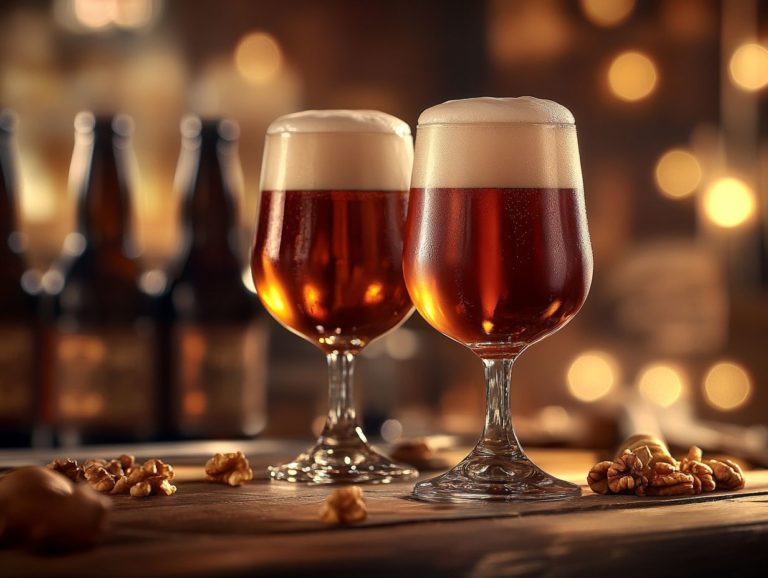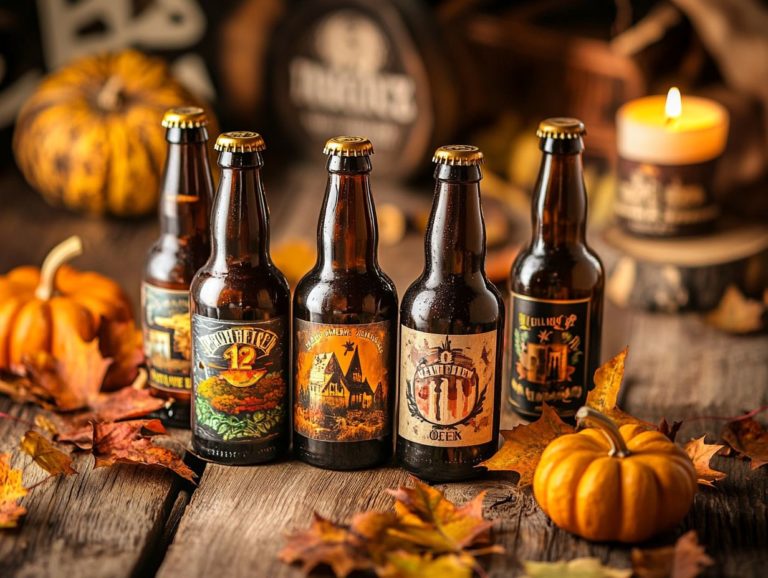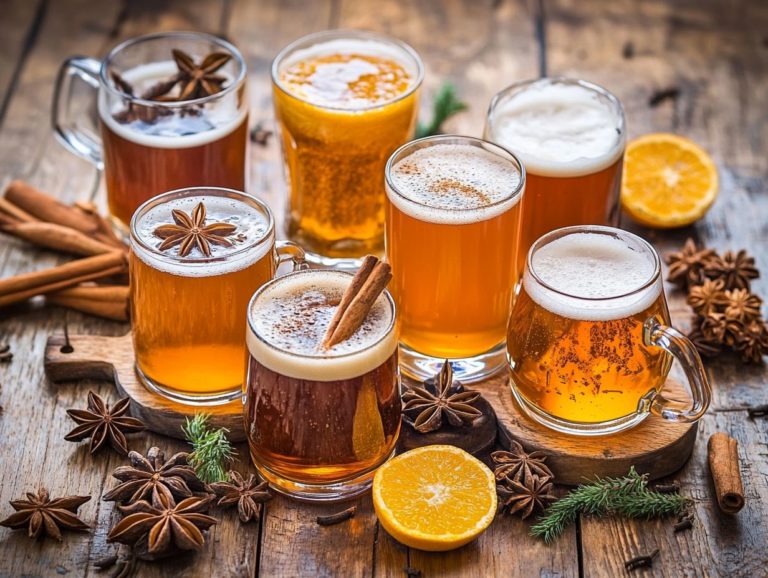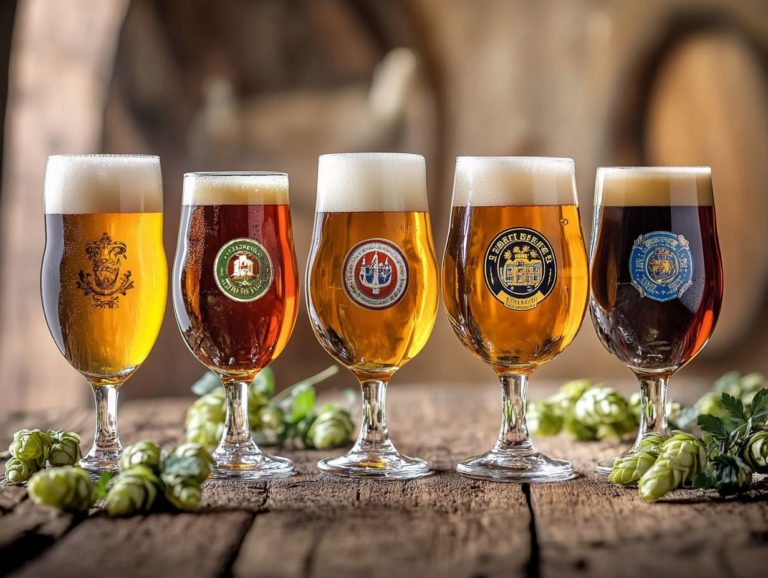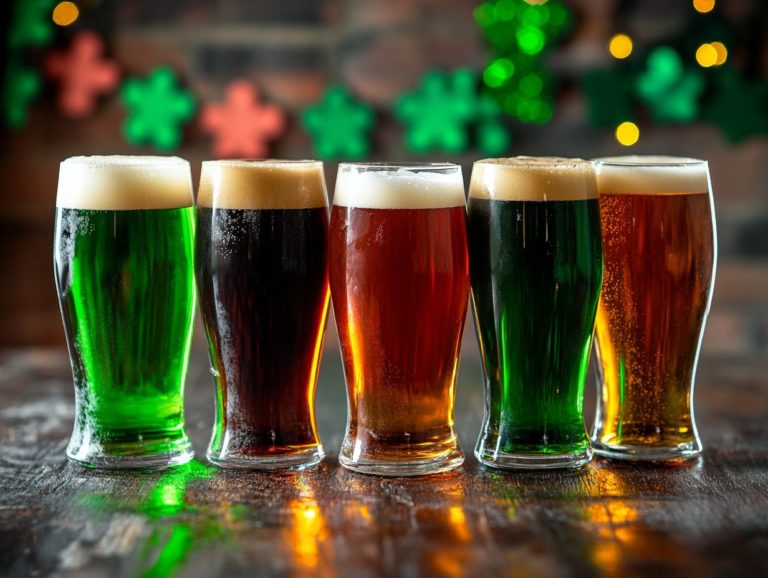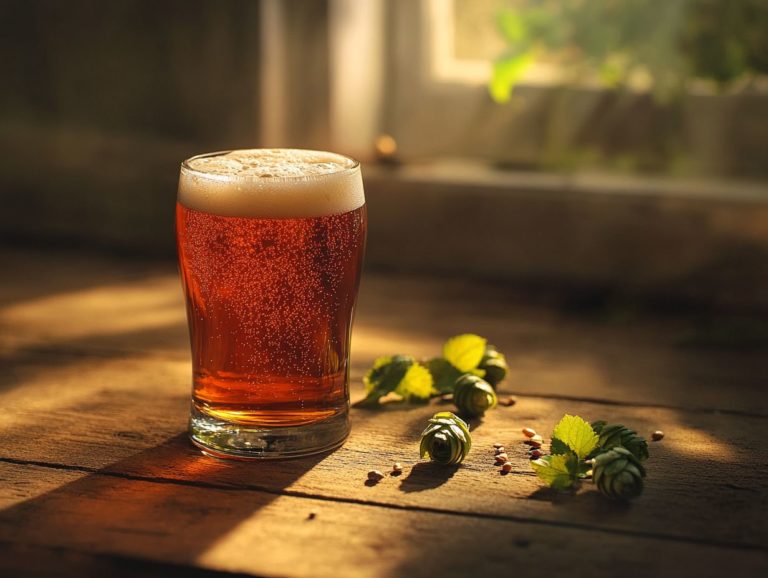5 Classic American Pale Ales to Sample
American Pale Ales have established themselves as a cherished staple in the craft beer realm, renowned for their harmonious flavors. These hop-forward beers are celebrated for their balance of hop bitterness and malt character, making them quintessential for any craft beer enthusiast.
In this article, you will explore five iconic examples that truly embody the style, including Sierra Nevada Pale Ale and Samuel Adams Boston Lager. You’ll learn about their unique brewing processes and how they utilize American hops to achieve their distinct flavor profiles.
You ll also explore what makes a pale ale an essential part of American brewing its key characteristics, variations, and the evolution it has undergone over the years. Understanding the fermentation temperature and water chemistry involved can deepen your appreciation for this classic American brew.
Discover the best food pairings and gain insights on how to distinguish exceptional pale ales from the ordinary. Learn about the importance of clean yeast and how it contributes to the overall drinkability of the beer.
Raise your glass and celebrate the timeless appeal of American Pale Ales! Whether you re enjoying it at a brewpub or at home, the craftsmanship behind each pint is something to be admired.
Contents
- Key Takeaways:
- 1. Sierra Nevada Pale Ale
- 2. Samuel Adams Boston Lager
- 3. New Belgium Fat Tire
- 4. Deschutes Mirror Pond Pale Ale
- 5. Anchor Steam Beer
- What Makes a Classic American Pale Ale?
- What Are the Key Characteristics of a Classic American Pale Ale?
- What Are the Different Variations of American Pale Ales?
- How Have American Pale Ales Evolved Over Time?
- How Can One Tell the Difference Between a Good and Bad American Pale Ale?
- Frequently Asked Questions
- Exploring American Pale Ales
Key Takeaways:
- 1. Sierra Nevada Pale Ale: A classic known for its bold hop flavor and citrus notes, achieved through meticulous brewing techniques.
- 2. New Belgium Fat Tire: A unique twist on the traditional pale ale with its use of Belgian yeast and careful recipe adjustments.
- 3. Anchor Steam Beer: A San Francisco classic with a balanced malt and hop profile, exemplifying traditional hops and innovative brewing methods.
1. Sierra Nevada Pale Ale
Sierra Nevada Pale Ale exemplifies the American Pale Ale style, celebrated for its bold hop characteristics and a well-balanced malt profile. This remarkable brew combines a rich brewing process with an exceptional hop aroma, setting a benchmark in the craft beer industry.
As you indulge in this iconic beverage, you’ll appreciate the unique techniques that showcase the vibrant flavors of American hops like Cascade and Centennial, essential to its signature taste. The hop aroma produced by these varieties is a hallmark of the style.
With meticulous attention to detail at every stage of the brewing process, this craft brewery amplifies the hoppy bitterness while allowing the aromatic profiles to truly shine. This results in an immersive drinking experience.
The profound influence of Sierra Nevada Pale Ale on the craft beer movement is undeniable. By elevating hop-forward flavors, it has inspired countless breweries to explore and innovate within their styles, ultimately shaping modern brewing trends across the nation.
2. Samuel Adams Boston Lager
Samuel Adams Boston Lager stands as a hallmark of the American craft beer movement, showcasing a rich malt character expertly complemented by a selection of traditional hops. This beer strikes a perfect balance of bitterness and flavor, appealing to a diverse array of beer enthusiasts.
Crafted from high-quality Maris Otter and Munich malts, this lager boasts a distinctively smooth and slightly sweet backbone, harmonizing beautifully with the floral and spicy notes derived from its carefully chosen hops. The brewing process employs a meticulous fermentation method that results in a complex profile, paying homage to traditional European styles while firmly rooting itself in American innovation.
Samuel Adams Boston Lager has left its mark on countless aspiring craft brewers, igniting a wave of lagers that emphasize rich flavors and quality ingredients. This beer serves as a benchmark in the lager category, thanks to its well-balanced and approachable nature, making it a standout choice that continues to draw in both seasoned aficionados and newcomers alike.
3. New Belgium Fat Tire
New Belgium Fat Tire is an amber ale that you re sure to love! It features a medium body and a distinctive residual sweetness, which refers to the sweetness left from sugars after fermentation. This beer strikes a perfect balance between subtle hop notes and a malt-forward flavor, solidifying its place as a staple in the craft beer world.
This exceptional brew reflects a commitment to quality craftsmanship. It uses fresh ingredients that add vibrant character and complexity to its profile. The brewing process is nothing short of meticulous. Careful control over fermentation temperatures enhances those delicate flavors and aromas, resulting in a well-rounded drinking experience.
As one of the original offerings from New Belgium Brewing, Fat Tire holds historical significance and has developed a loyal following among craft beer enthusiasts. They appreciate not only its remarkable flavor but also what it represents in the ever-evolving beer culture.
This amber ale stands as a testament to the brewery’s passion for innovation and dedication to environmental sustainability. It s a choice you can feel good about savoring!
4. Deschutes Mirror Pond Pale Ale
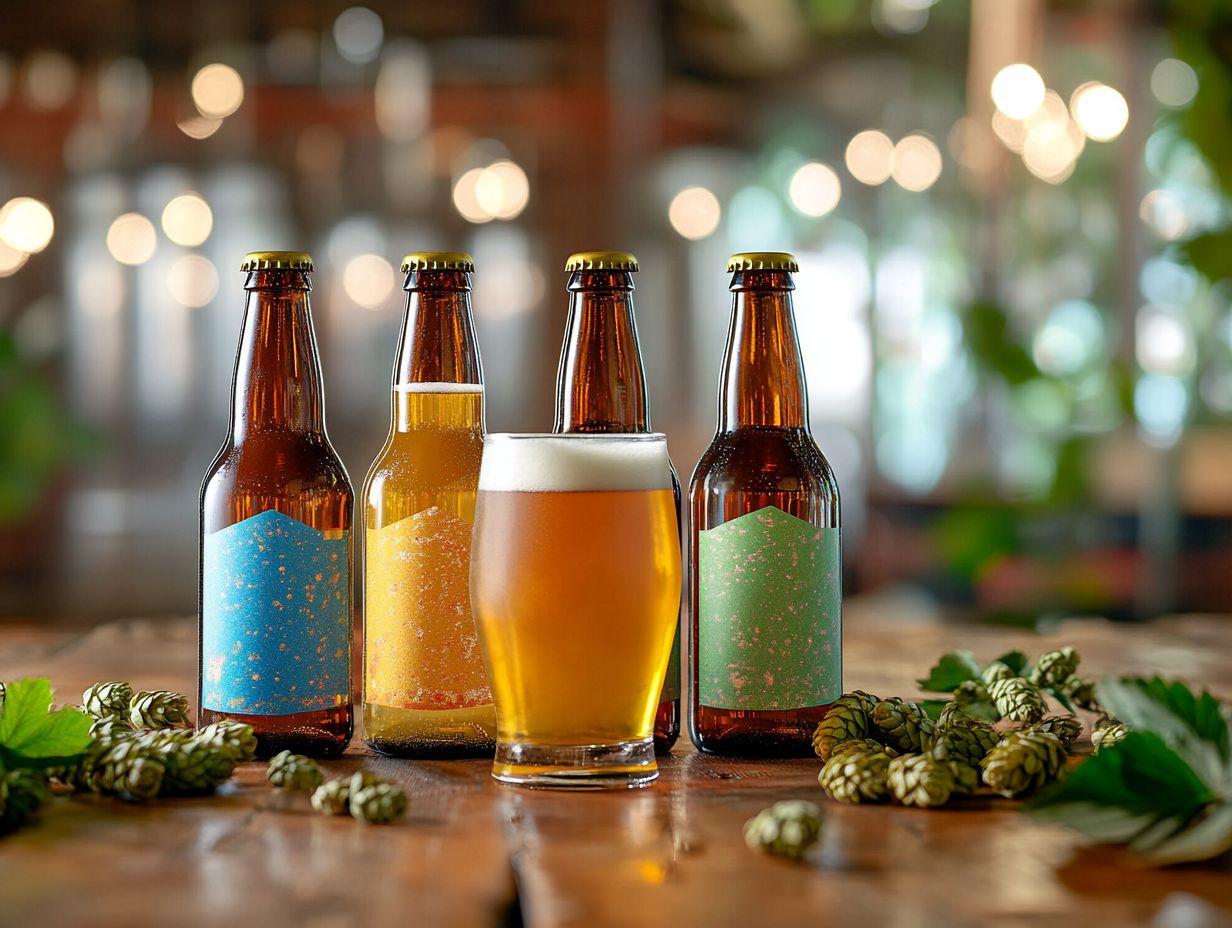
Deschutes Mirror Pond Pale Ale stands out for its floral flavor and well-balanced hop bitterness. This is a testament to the brewery’s commitment to crafting exceptional American Pale Ales that truly capture the essence of the hoppy beer style.
The use of American hop varieties like Cascade and Centennial is crucial in creating its distinctive taste. It is often described as a harmonious blend of citrus and pine notes. You ll appreciate the meticulous brewing records kept by Deschutes, showcasing their dedication to consistency.
The brewers expertly fine-tune each batch. They employ techniques such as precise temperature control and a careful balance of malt and hops.
This level of attention to detail elevates the beer’s refreshing quality. Each sip serves as a delightful reminder of the craftsmanship that goes into this iconic beverage.
5. Anchor Steam Beer
Anchor Steam Beer is a hallmark of the California common style. It is celebrated for its distinctive brewing techniques that harness a warm fermentation process. This results in a remarkably smooth and drinkable beer, steeped in rich history within the American brewing landscape.
This innovative approach traces back to the 19th century, a period ripe with experimentation in American brewing. Faced with the challenges of limited refrigeration, the brewery ingeniously developed a method that merges lager and ale brewing techniques. This is a true testament to skill and creativity!
The specific yeast strain employed is a top-fermenting variety that flourishes in warmer temperatures. This lends the beer its signature flavor profile. By using traditional ingredients like pale malt and hops sourced from the Pacific Northwest, Anchor Steam Beer transforms from a mere beverage into a celebration of the resilience and artistry inherent in American brewing.
What Makes a Classic American Pale Ale?
Aroma
A classic American Pale Ale is all about that hop-forward profile, showcasing vibrant hop varieties and brewing techniques that define its character. You ll find a balanced bitterness, malt complexity, and an overall drinkability that appeals to a wide range of craft beer enthusiasts.
As you take a sip, the hop aroma greets you with notes of citrus, pine, and floral elements. This entices you with its inviting fragrance.
Flavor
Meanwhile, the malt character delivers a sturdy backbone, often bringing forth caramel and toasty flavors that elevate your tasting experience. Don t overlook the yeast selection the subtle fruity esters it imparts round out the profile beautifully.
Brewing Techniques
For brewers, keeping meticulous brewing records and utilizing advanced software becomes essential for refining these characteristics. This ensures both consistency and quality. You can find modern examples of this style all across the United States. Each boasts regional variations that reflect local ingredients and brewing traditions, illustrating just how versatile this beloved beer style truly is.
What Are the Key Characteristics of a Classic American Pale Ale?
The hallmark traits of a classic American Pale Ale are distinctive. They feature a pronounced hop flavor and a well-balanced body.
Expect vibrant hop flavors that showcase delightful citrus notes from varieties such as Cascade and Amarillo. These are accompanied by the resinous qualities of pine hops.
This exciting mix can evoke aromas reminiscent of fresh grapefruit or the earthy essence of pine forests.
On the malt side, crystal malts contribute a subtle sweetness and a hint of light caramel. This perfectly complements the hops without overshadowing them.
These grains are part of a simple grain bill that ensures a clean fermentation. Techniques like dry hopping elevate both aroma and flavor, enhancing the beer’s freshness.
Notable examples of this style, such as Sierra Nevada Pale Ale and Stone Pale Ale, embody these characteristics and have rightfully earned their place as staples in the craft beer community.
What Are the Different Variations of American Pale Ales?
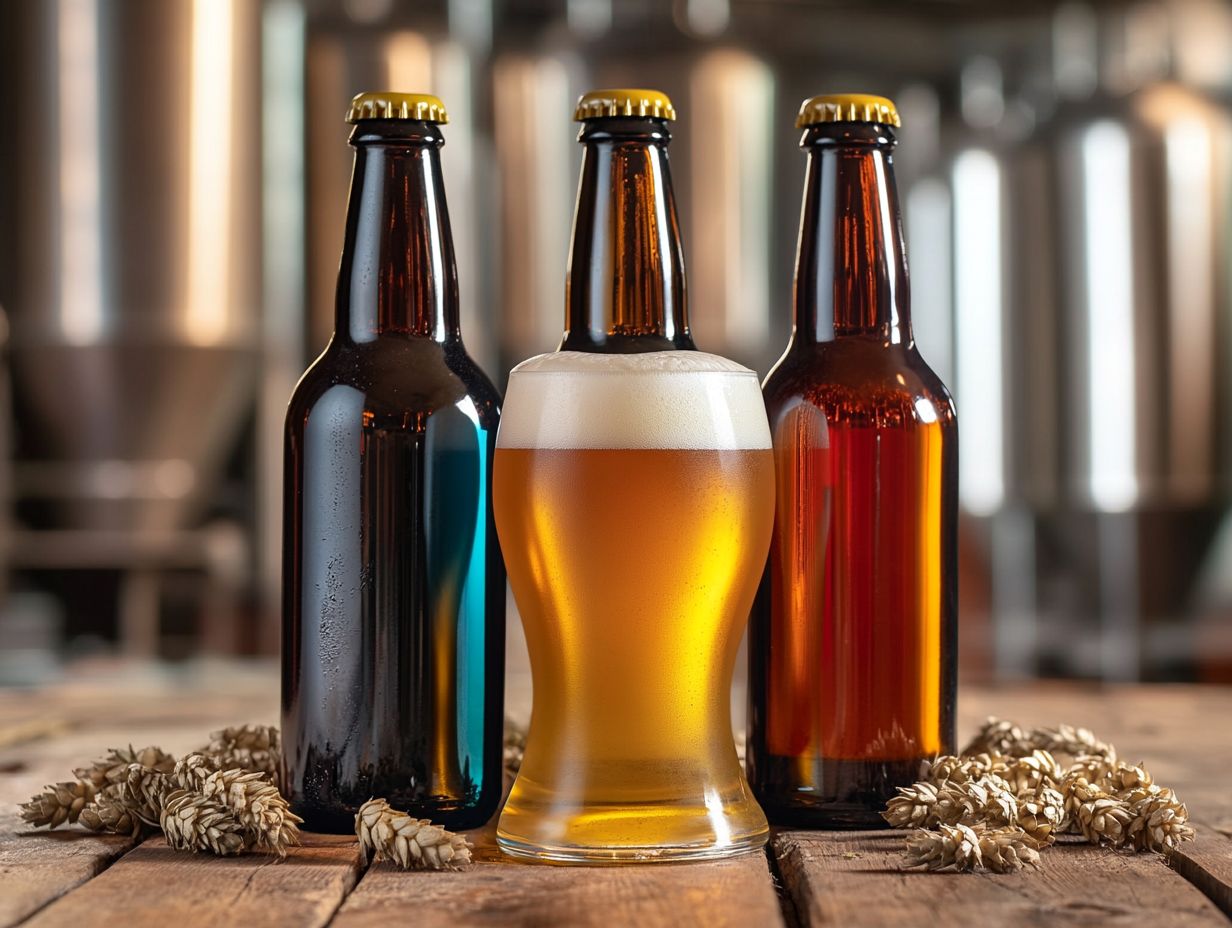
American Pale Ales present a delightful array of styles and interpretations. Each one showcases different hop combinations and regional variations.
Discover these exciting variations ranging from the assertive hop bitterness typical of West Coast styles to the more balanced, malt-forward profiles in some Midwest versions.
Each of these regional variations reflects different approaches to hop utilization and fermentation health.
For instance, breweries in California often go all-in on bold citrus and pine flavors, with iconic choices like Sierra Nevada leading the charge.
In contrast, Chicago s brewing scene embraces a smoother, more restrained approach. This reflects the tradition of English Pale Ales while adding a touch of American flair.
This variety underscores the importance of regional variation in shaping modern American Pale Ales.
As you delve into these distinctive styles, it becomes clear that local ingredients and brewing techniques play a vital role.
Whether you’re exploring hoppy beers or those with a more rounded malt character, the brewing process and the choice of ingredients in beer greatly influence the final product.
How Have American Pale Ales Evolved Over Time?
The evolution of American Pale Ales showcases notable shifts in brewing techniques and style preferences. This evolution has been spurred by innovation and competition within the craft beer industry.
This dynamic environment has led to a remarkable array of flavors and styles, highlighting the importance of flavor hops and yeast selection.
If you trace the history back to the mid-20th century, you’ll find that these ales began gaining traction. Brewers ventured beyond traditional European methods, experimenting with indigenous ingredients and bold hop varieties.
Over the decades, American Pale Ales have evolved from simple, malt-centric brews into complex, hop-driven masterpieces.
This transformation was fueled by the rise of brewing competitions, which celebrated creativity and pushed brewers to craft unique recipes to stand out in an ever-growing market.
The use of American hops and advancements in water chemistry and fermentation temperature control have also played crucial roles in this evolution.
As consumer tastes fluctuate, brewers face the ongoing challenge of adapting while still honoring the authenticity of classic styles.
This includes mastering hop utilization, maintaining fermentation health, and making recipe adjustments to meet seasonal demands.
Explore the world of American Pale Ales and find your favorite style today!
What Are the Best Food Pairings for American Pale Ales?
American Pale Ales offer remarkable versatility, making them the perfect pairing for a wide array of foods, from grilled meats to spicy dishes and artisanal cheeses. Their balanced flavor profile and medium body give you the flexibility to enhance your dining experience, regardless of the regional variation in cuisines.
This adaptability arises from their moderate bitterness and citrusy hop notes, which elevate a dish s flavor while providing a refreshing contrast. Imagine the bright hop character of an American Pale Ale accentuating the savory notes of smoky barbecue, with its carbonation cutting through the richness. It’s a match made in culinary heaven, especially for barbecued ribs.
The clean fermentation process also ensures that these beers present a balanced palate that complements a wide range of foods. Dishes featuring bold spices, like Indian curries or Mexican tacos, can also thrive alongside these ales, benefitting from the fruity or floral smells and mild sweetness they bring.
To ensure a successful pairing, consider exploring brewing techniques like dry hopping which means adding hops during fermentation to enhance flavor or using caramelly malts to highlight flavors that complement specific cuisines. Don’t forget to consider seasonal fit when selecting your pairings for a more harmonious dining experience.
A personal tip for you: dive into the adventure of trying various beers with your favorite dishes to discover that perfect match! Using brewing software can help you track your brewing records and make better adjustments for future pairings.
How Can One Tell the Difference Between a Good and Bad American Pale Ale?
Distinguishing between a good and a bad American Pale Ale requires you to assess flavor balance, aroma clarity, and the artistry of brewing. A well-crafted brew will exhibit clean yeast fermentation and a harmonious hop bitterness that delights the palate.
The use of fresh ingredients and attention to carbonation levels are also key indicators of quality. Beyond these core elements, you should also consider the interplay of malt sweetness and hop character, as this combination is vital in creating the harmony that defines an outstanding APA.
Pay close attention to the aroma; fresh hops can deliver tantalizing citrusy, floral, or pine notes that significantly enhance your overall tasting experience. The choice of hop combinations and the use of Maris Otter malt or Munich malt can further elevate the beer’s complexity.
Evaluating the mouthfeel is crucial as well. A quality American Pale Ale should present a medium body that feels smooth not watery or overly thick. Be on the lookout for common flaws, such as off-flavors resulting from improper fermentation or oxidation, which can seriously detract from the intended sensory journey.
Monitoring fermentation health and maintaining a simple grain bill can help prevent these issues. Ultimately, using fresh ingredients and maintaining meticulous brewing records can elevate the quality of your final product, leading to a truly exceptional beer that stands out in the crowded craft beer landscape.
Additionally, improving your homebrewer skills through practice and experimentation can greatly enhance your brewing experience.
Frequently Asked Questions
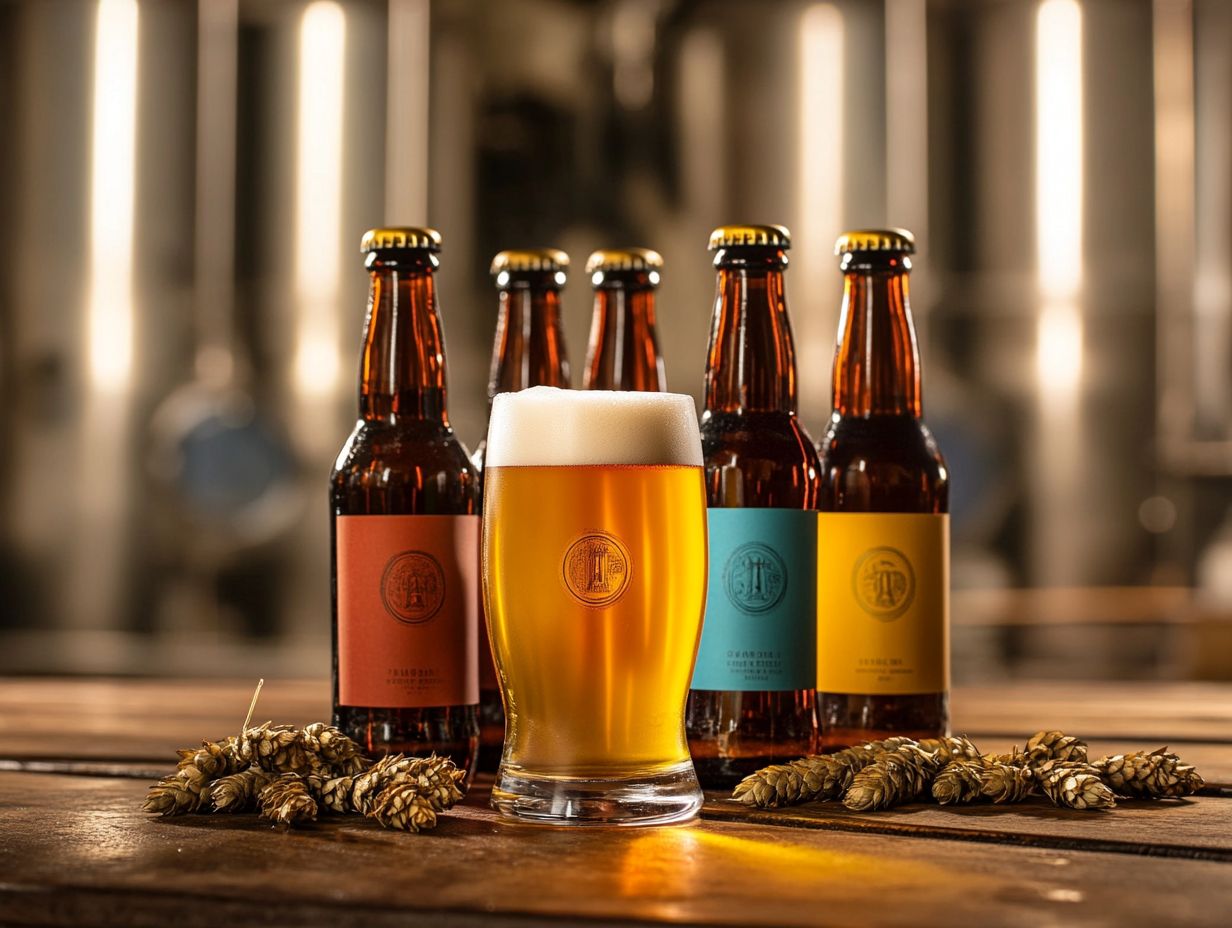
What are the top 5 classic American pale ales to sample?
The top 5 classic American pale ales to sample are Sierra Nevada Pale Ale, Anchor Liberty Ale, New Belgium Fat Tire, Lagunitas IPA, and Bell’s Two Hearted Ale.
What makes Sierra Nevada Pale Ale a must-try American pale ale?
Sierra Nevada Pale Ale is a classic example of the American pale ale style, with a balanced and hop-forward flavor profile. It has been consistently highly rated and is often considered the beer that sparked the craft beer revolution in the United States.
Why should I try Anchor Liberty Ale?
Anchor Liberty Ale is a historically significant American pale ale, as it was the first modern American craft beer to use Cascade hops. It has a crisp and refreshing taste with a well-balanced hop profile.
Explore different American Pale Ales and share your experiences your perfect beer match awaits!
Exploring American Pale Ales
What sets New Belgium Fat Tire apart from other American pale ales?
New Belgium Fat Tire is a unique American pale ale with a Belgian twist. It features a toasty malt character and subtle fruitiness from the Belgian yeast.
Why is Lagunitas IPA a popular choice among American pale ale lovers?
Lagunitas IPA is a bold, hop-forward American pale ale. It offers a strong citrus and piney aroma with a well-balanced bitterness and smooth finish.
What makes Bell’s Two Hearted Ale a must-try American pale ale?
Bell’s Two Hearted Ale is a must-try American pale ale. Its rich hop profile and intense fruity and floral notes will leave you craving more!

